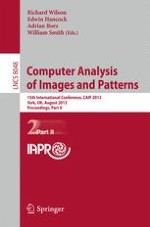The two volume set LNCS 8047 and 8048 constitutes the refereed proceedings of the 15th International Conference on Computer Analysis of Images and Patterns, CAIP 2013, held in York, UK, in August 2013. The 142 papers presented were carefully reviewed and selected from 243 submissions. The scope of the conference spans the following areas: 3D TV, biometrics, color and texture, document analysis, graph-based methods, image and video indexing and database retrieval, image and video processing, image-based modeling, kernel methods, medical imaging, mobile multimedia, model-based vision approaches, motion analysis, natural computation for digital imagery, segmentation and grouping, and shape representation and analysis.
